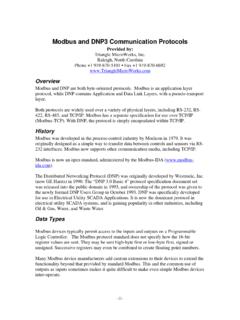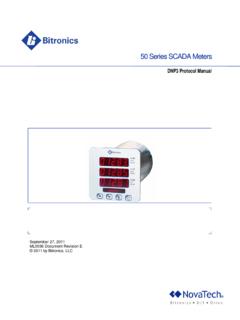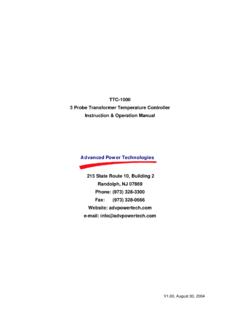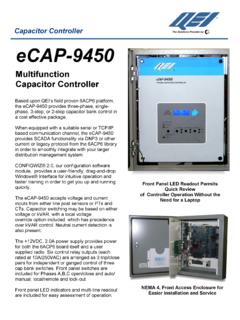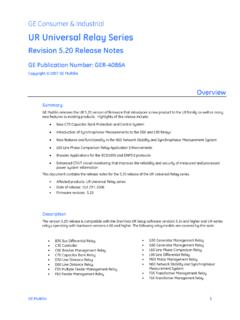Transcription of DNP3 Application Note AN2013-004b Validation of Incoming ...
1 dnp3 Application Note AN2013-004b Validation of Incoming dnp3 Data Revision History Version Date Reason for Changes an2013 -004 11-December-2013 Initial release. an2013 -004a 29-June-2014 Correction to row 7 of Table 1: is invalid or marked as NOT_SUPPORTED was replaced with is invalid or is not supported by the device . AN2013-004b 13-August-2014 Correction to row 17 of Table 1: Incoming broadcast messages shall be rejected if the control function code is anything other than 3 (CONFIRMED_USER_DATA) or 4 (UNCONFIRMED_USER_DATA). Removal of row 18 of Table 1 The frame's DESTINATION field is set to one of the three broadcast addresses, and the FCV bit is set to 1.. 1 Introduction The stable and secure operation of SCADA systems is a high-priority issue. One component of SCADA robustness involves the Validation of Incoming messages.
2 This Application Note details numerous checks that should be performed on received data, in order to verify that the data comprises a valid dnp3 message. This document assumes that the reader is knowledgeable about the dnp3 Primary-Secondary transaction and the various components of a dnp3 message as specified in IEEE StdTM 1815-2012. Detailed explanations are included in IEEE 1815 and are not repeated in this document; references to specific sections in IEEE 1815 are included where appropriate. The figures included in this document are duplicated from Appendix B of IEEE 1815, and are reproduced here for ease of reference. 2 Details This document refers to behavior of Master and Outstation devices. The Validation that should be performed by a Master is not always the same as the Validation that should be performed by an Outstation.
3 Also, one device may perform the actions of both a Master and an Outstation ( data concentrators). Depending on whether the Incoming data was received by the Master or Outstation module, it may be necessary to validate the data differently. Validation of Incoming data is an essential element of good programming practices. This document includes general recommendations, as well as layer-dependent details for robust handling of data/message Validation . General Coding Recommendations The recommendations below use the terms robust and reasonable . The implementer must determine what robust and reasonable mean in regards to the device being implemented. Page 1 13-August-2014 AN2013-004b Validation of Incoming dnp3 Data Logging (what is logged, as well as changeable log levels) should be considered as a component of robust handling of error conditions.
4 Parse and validate all Incoming data using a trust nothing approach before processing it or performing any actions based on the data. The code must reflect the functionality of the device; the developer must know the device and what is to be implemented. Validation of object data should be robust and object-dependent; the handling of unexpected/invalid data will need to be device-dependent and well-thought-out ( master requests that do not apply to an outstation s specific functionality, timestamps that contain invalid values that cannot be converted to a realistic internal time, counter values that decrease, etc.). Stop parsing when a non-recoverable failure ( invalid function code) is encountered, and do not parse any further objects in the fragment. Perform testing of boundary conditions, and combinations of boundary conditions.
5 Perform a reasonableness test before allocating or consuming resources ( unreasonable number of objects/points). Verify that resource allocation has succeeded before attempting to use the resources. It is important to know how to check for the failure; it is not easy in all systems. Failure cases should be handled robustly. Appropriate variable types should be used to avoid integer overflows, truncation, or negative numbers. Calculations based on index ranges require the use of integer types with a larger bit-width than the size of the index contained in the message ( a count of objects in a 2-byte start/stop header could use a 32-bit integer for correct representation). Avoid unintended sign extension by masking values when copying from smaller to larger integers.
6 This especially applies when reading a value from a character array into an integer type. Unsigned declarations don t always work as expected. Ensure that sign bits and truncation are handled correctly when translating 48-bit dnp3 time to 32-bit internal timestamps. Ensure that the parsing/processing of variable-length data, file transfer, etc. is robust in order to avoid accessing out-of-bound memory. Consider the removal of debugging artifacts and associated constructs from the production code. When discarding messages, all code artifacts should be tidied up ( buffers reset/cleared, variables reset to default values, etc.) so that subsequent processing does not encounter remnants from previous messages. All fields of all data objects should be checked for "reasonable" or valid values ( bits in flag words, values of code fields, etc.)
7 APIs should validate all data for applications . Types passed across API boundaries should be as strong as possible to prevent potential integration vulnerabilities. Adopt a holistic Security Development Life-cycle (SDL) that includes, but is not limited to, code reviews, static & dynamic analysis, and fuzz testing ( , , ). Page 2 13-August-2014 AN2013-004b Validation of Incoming dnp3 Data Data Link Layer IEEE 1815 Clause 9 Data Link Layer provides a framework for implementing a Data Link Layer. Additional verifications and checks are required for a robust Data Link Layer. Page 3 13-August-2014 AN2013-004b Validation of Incoming dnp3 Data Data Link Layer Start Len Ctrl Destination Source CRC 0x05 0x64 LSB MSB LSB MSB LSB MSB Header Block 7 6 5 4 3 2 1 0 bit number DIR PRM FCB FCV Function Code Primary to secondary 0 DFC Secondary to primary Primary Function Code Function Code Name FCV Bit Secondary Function Code Function Code Name 0 RESET_LINK_STATES 0 0 ACK 1 1 NACK 2 TEST_LINK_STATES 1 2 3 CONFIRMED_USER_DATA 1 3 4 UNCONFIRMED_USER_DATA 0 4 5 5 6 6 7 7 8 8 9 REQUEST_LINK_STATUS 0 9 A A B B LINK_STATUS C C D D E E F F NOT_SUPPORTED Primary to secondary (PRM = 1) Secondary to primary (PRM = 0)
8 Control octet 5 to 255 1 = From Master 0 = From Outstation 1 = Primary to Secondary 0 = Secondary to Primary 0 to 65519 0 to 65535 FCB: Frame Count Bit Alternates 1 and 0 FCV: Frame Count Valid 1 = examine FCB bit 0 = ignore FCB bit DFC: Data Flow Control 1 = receive buffer full 0 = receive buffer available Figure 1 - Data link layer header breakout Page 4 13-August-2014 AN2013-004b Validation of Incoming dnp3 Data Table 1 details conditions that shall cause Incoming data to be ignored (discarded) by the Data Link Layer. After data has been discarded, the monitoring of the Incoming data to locate a new start-of-message (0x05 0x64) shall recommence with the data received immediately after the discarded data. The Master & Outstation columns in Table 1 serve several purposes.
9 An N/A entry in a cell indicates that the feature does not apply to a device of that type. Developers may wish to enter a checkmark in each blank cell as they verify and test code. Table 1 Erroneous data which shall cause Incoming data to be ignored by the Data Link Layer Ignore (discard) the received data if: Master Outstation IEEE 1815-2012 Reference The first octet is not set to 0x05. The second octet is not set to 0x64. The value of the third octet (the frame's LENGTH field) is less than 5. The value of the third octet (the frame's LENGTH field) plus 3 plus the count of CRC octets is greater than the device s maximum received frame size. , The value of the frame's LENGTH field plus 3 plus the count of CRC octets is greater than the actual number of octets received.
10 , Any of the 16-bit CRC fields is incorrect (1 to 16 CRC fields per frame, depending on the frame size). , , Annex E The combination of PRM bit, FCV bit and function code in the CONTROL field (fourth octet of the frame) is invalid or is not supported by the device. ; Annex B Valid Data Link Layer Control Codes The frame's CONTROL function code is set to 3 or 4 (USER_DATA), and the value of the LENGTH field is less than 6. The value of the frame's CONTROL function code is something other than 3 or 4, and the value of the LENGTH field is not equal to 5. The frame's PRM bit is clear (Secondary message), but the device is not currently expecting a Secondary message. The Secondary message contains a CONTROL function code that is not a permitted response to the function code that was used in the Primary message.

